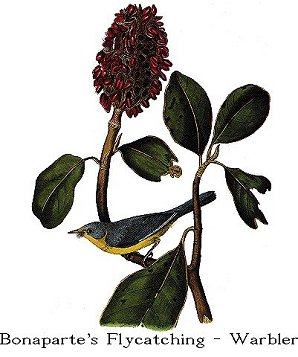
| Family VIII. SYLVICOLINAE. WOOD-WARBLERS. GENUS I. MYIODIOCTES, Aud. FLYCATCHING-WARBLER. |
Next >> |

Family |
BONAPARTE'S FLYCATCHING-WARBLER. [Canada Warbler (see also Canada Flycatcher).] |
| Genus | MYIODIOCTES BONAPARTII, Aud. [Wilsonia canadensis.] |
Whilst I have the pleasure of honouring this
beautiful new species with the name of so distinguished a naturalist as CHARLES
LUCIEN BONAPARTE, Prince of Musignano, I regret that I am unable to give any
account of its habits, or even of its manner of flight, and must therefore confine
my remarks upon it within very brief space. The following extract from my journal
contains all that I have to say respecting it.
"Monday, August 13, 1821. Louisiana.--On arriving at the Cypress Swamp
(about five miles from St. Francisville) I saw a great number of small birds of
different species, and as I looked at them I observed two engaged in a fight or
quarrel. I shot at them, but only one fell. On reaching the spot, I found the
bird was only wounded, and saw it standing still and upright as if stupefied by
its fall. When I approached it to pick it up, it spread its tail, opened its
wings, and snapped its bill about twenty times sharply and in quick succession,
as birds of the genus do when seizing insects on wing. I carried it home, and
had the pleasure of drawing it while alive and full of spirit. It often made
off from my hand, by starting suddenly, and then would hop round the room as
quickly as a Carolina Wren, uttering its tweet, tweet, tweet all the while, and
snapping its bill every time I took it up. I put it into a cage for a few
minutes, but it obstinately thrust its head through the lower parts of the
wires. I relieved it from this sort of confinement, and allowed it to go about
the room. Next day it was very weak and ruffled up, so I killed it and put it
in spirits." To this account I have only to add, that I have not seen another
individual since.
BONAPARTE'S FLYCATCHER, Muscicapa Bonapartii, Aud. Orn. Biog.,vol. i. p. 27.
Bristles longer than in the last, second quill longest; tail very long,
nearly even; upper parts light greyish-blue; quills dusky brown, their outer
webs greyish-blue, the two outer margined with white; middle tail-feathers and
edges of the rest like the back; lower parts and a band on the forehead
ochre-yellow, with a few faint dusky spots on the lower part of the fore neck.
This species differs from the last chiefly in being of a more elongated form, in
baying the bristles much longer, the upper parts of a much lighter tint; in
wanting the black band down the side of the neck, and the yellow band over the
eye; the bill is straighter and more pointed, and the outer primaries are edged
with white.
Male, 5 1/4.
Louisiana. Only one specimen ever found.
THE GREAT MAGNOLIA.
MAGNOLIA GRANDIFLORA, Willd., Sp. Pl., vol. ii. p. 1255.
Pursch, Flor. Amer., vol. ii. p. 380. Mich., Arbr. Forest. de l'Amer. Sept.,
vol. iii. p. 71. Pl. i.--POLYANDRIA POLYGYNIA, Linn.--MAGNOLIAE, Juss.
The magnificent tree, of which a twig, with a cone of ripe fruit, is
represented in the plate, attains a height of a hundred feet or even more. The
bright red bodies are the seeds, suspended by a filament for some time after the
capsules have burst. The trunk is often very straight, from two to four feet in
diameter at the base, with a greyish smooth bark. The leaves which remain
during the winter are stiff and leathery, smooth, elliptical, tapering at the
base. The flowers are white, and seven or eight inches in diameter. It is
known by the name of large magnolia, big laurel and bay-tree, and occurs
abundantly in some parts of Carolina, Georgia, the Floridas and Louisiana.
| Next >> |